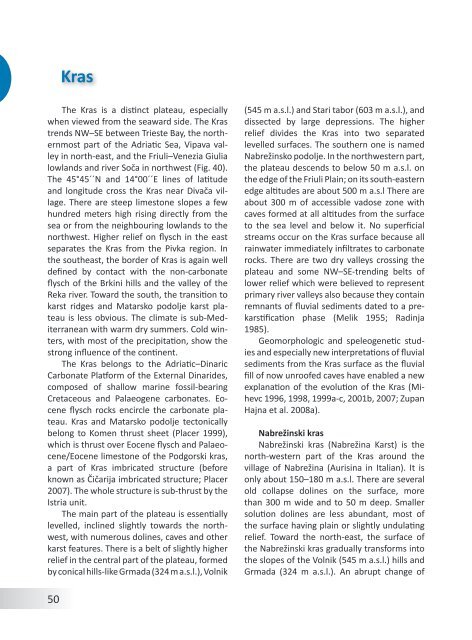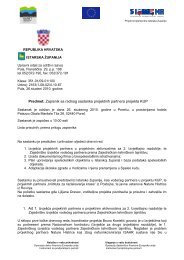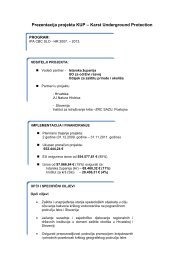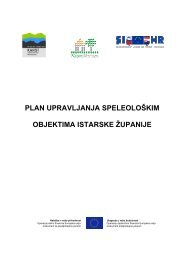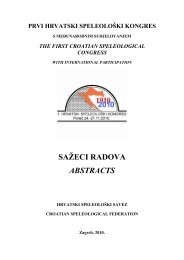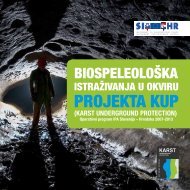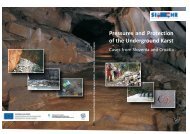<strong>Case</strong> <strong>Studies</strong> <strong>from</strong> <strong>the</strong> <strong>Dinaric</strong> <strong>Karst</strong> <strong>of</strong> <strong>Slovenia</strong>Andrej Mihevc, Nadja Zupan Hajna, Mitja PrelovšekThe <strong>Dinaric</strong> karst (Dinarski kras) is <strong>the</strong>major karst area <strong>of</strong> <strong>Slovenia</strong>. In past centuries,<strong>the</strong> Dinarski kras <strong>of</strong> <strong>Slovenia</strong> represented one<strong>of</strong> <strong>the</strong> world’s prime sites <strong>of</strong> early scientificexploration <strong>of</strong> karst phenomena (Kranjc1997; Shaw 1992) due to <strong>the</strong> large number <strong>of</strong>outstanding karst features such as caves, largesinking rivers and flooded poljes. Speleology,karst hydrology and biospeleology were bornhere. The most prominent phenomena aresituated in <strong>the</strong> north-western part on <strong>the</strong>plateau named Kras. In Slovene language, krasmeans a rocky, barren surface. The name is<strong>of</strong>ten used as toponym (Kranjc 1994, 1997). Krasplateau became a textbook example for thiskind <strong>of</strong> landscape because <strong>of</strong> <strong>the</strong> extraordinarykarst phenomena, and explorations done in<strong>the</strong> 19 th Century. The name Kras in <strong>the</strong> Germanform <strong>of</strong> <strong>the</strong> word (der <strong>Karst</strong>) became aninternational scientific term. The area where<strong>the</strong>se early explorations took place is called<strong>the</strong> Classical <strong>Karst</strong> (term introduced by Radinja1966, also 1972 as Matični Kras; which shouldnot be confused with <strong>the</strong> misinterpretation byŠušteršič 2000).The dominant relief features are ra<strong>the</strong>rextensive levelled surfaces at differentelevations, large closed depressions (e.g.,poljes), and conical hills. Fluviokarst featureslike dells are common on dolomites. <strong>Karst</strong>rivers appear only in <strong>the</strong> bottoms <strong>of</strong> poljes,where <strong>the</strong>y result <strong>from</strong> a high level <strong>of</strong> karstwater. Allogenic rivers flowing <strong>from</strong> noncarbonateregions ei<strong>the</strong>r sink at <strong>the</strong> karstboundary, forming blind valleys, or cross <strong>the</strong>karst through deep karst valleys and canyons.There are numerous extensive and complicatedcave systems formed by sinking rivers andconnected with <strong>the</strong> surface also by numerousvadose shafts. The surface karst morphology istypified by <strong>the</strong> abundance <strong>of</strong> karren, dolines<strong>of</strong> various diameters and depths, sometimesextensive collapse dolines, cave entrances,unro<strong>of</strong>ed caves, etc.For <strong>the</strong> <strong>Dinaric</strong> karst <strong>of</strong> <strong>Slovenia</strong>, twotypes <strong>of</strong> relief are characteristic: High <strong>Dinaric</strong>karst (high karst plateaus: Javorniki, Hrušica,Nanos, Trnovski gozd, Banjščice and Snežnik)and Low <strong>Dinaric</strong> karst (karst in <strong>the</strong> lowerparts: Notranjsko podolje, Pivka basin, Kras).There are presented limestones and dolomites<strong>of</strong> Permian, Triassic, Jurassic, Cretaceous andPaleogene, cut by faults in <strong>the</strong> dominant <strong>Dinaric</strong>direction (i.e., NW-SE). The most dominantkarst forms in <strong>the</strong> area are dolines, collapsedolines, karst poljes and high plateaus (Mihevc1997). The main factor in relief developmenthas been <strong>the</strong> dissolution process; o<strong>the</strong>rs(fluvial erosion, slope processes, etc.) have asubordinate role. Along Idrija Fault <strong>the</strong> mainkarst poljes in <strong>Slovenia</strong> are developed: Loškopolje (Lož polje), Cerkniško polje (Cerknicapolje), Planinsko polje (Planina polje). Thereare many caves developed, among which is <strong>the</strong>outstanding Postojna caves system with about20 km <strong>of</strong> known passages.49
KrasThe Kras is a distinct plateau, especiallywhen viewed <strong>from</strong> <strong>the</strong> seaward side. The Krastrends NW–SE between Trieste Bay, <strong>the</strong> nor<strong>the</strong>rnmostpart <strong>of</strong> <strong>the</strong> Adriatic Sea, Vipava valleyin north-east, and <strong>the</strong> Friuli–Venezia Giulialowlands and river Soča in northwest (Fig. 40).The 45°45´´N and 14°00´´E lines <strong>of</strong> latitudeand longitude cross <strong>the</strong> Kras near Divača village.There are steep limestone slopes a fewhundred meters high rising directly <strong>from</strong> <strong>the</strong>sea or <strong>from</strong> <strong>the</strong> neighbouring lowlands to <strong>the</strong>northwest. Higher relief on flysch in <strong>the</strong> eastseparates <strong>the</strong> Kras <strong>from</strong> <strong>the</strong> Pivka region. In<strong>the</strong> sou<strong>the</strong>ast, <strong>the</strong> border <strong>of</strong> Kras is again welldefined by contact with <strong>the</strong> non-carbonateflysch <strong>of</strong> <strong>the</strong> Brkini hills and <strong>the</strong> valley <strong>of</strong> <strong>the</strong>Reka river. Toward <strong>the</strong> south, <strong>the</strong> transition tokarst ridges and Matarsko podolje karst plateauis less obvious. The climate is sub-Mediterraneanwith warm dry summers. Cold winters,with most <strong>of</strong> <strong>the</strong> precipitation, show <strong>the</strong>strong influence <strong>of</strong> <strong>the</strong> continent.The Kras belongs to <strong>the</strong> Adriatic–<strong>Dinaric</strong>Carbonate Platform <strong>of</strong> <strong>the</strong> External Dinarides,composed <strong>of</strong> shallow marine fossil-bearingCretaceous and Palaeogene carbonates. Eoceneflysch rocks encircle <strong>the</strong> carbonate plateau.Kras and Matarsko podolje tectonicallybelong to Komen thrust sheet (Placer 1999),which is thrust over Eocene flysch and Palaeocene/Eocenelimestone <strong>of</strong> <strong>the</strong> Podgorski kras,a part <strong>of</strong> Kras imbricated structure (beforeknown as Čičarija imbricated structure; Placer2007). The whole structure is sub-thrust by <strong>the</strong>Istria unit.The main part <strong>of</strong> <strong>the</strong> plateau is essentiallylevelled, inclined slightly towards <strong>the</strong> northwest,with numerous dolines, caves and o<strong>the</strong>rkarst features. There is a belt <strong>of</strong> slightly higherrelief in <strong>the</strong> central part <strong>of</strong> <strong>the</strong> plateau, formedby conical hills-like Grmada (324 m a.s.l.), Volnik(545 m a.s.l.) and Stari tabor (603 m a.s.l.), anddissected by large depressions. The higherrelief divides <strong>the</strong> Kras into two separatedlevelled surfaces. The sou<strong>the</strong>rn one is namedNabrežinsko podolje. In <strong>the</strong> northwestern part,<strong>the</strong> plateau descends to below 50 m a.s.l. on<strong>the</strong> edge <strong>of</strong> <strong>the</strong> Friuli Plain; on its south-easternedge altitudes are about 500 m a.s.l There areabout 300 m <strong>of</strong> accessible vadose zone withcaves formed at all altitudes <strong>from</strong> <strong>the</strong> surfaceto <strong>the</strong> sea level and below it. No superficialstreams occur on <strong>the</strong> Kras surface because allrainwater immediately infiltrates to carbonaterocks. There are two dry valleys crossing <strong>the</strong>plateau and some NW–SE-trending belts <strong>of</strong>lower relief which were believed to representprimary river valleys also because <strong>the</strong>y containremnants <strong>of</strong> fluvial sediments dated to a prekarstificationphase (Melik 1955; Radinja1985).Geomorphologic and speleogenetic studiesand especially new interpretations <strong>of</strong> fluvialsediments <strong>from</strong> <strong>the</strong> Kras surface as <strong>the</strong> fluvialfill <strong>of</strong> now unro<strong>of</strong>ed caves have enabled a newexplanation <strong>of</strong> <strong>the</strong> evolution <strong>of</strong> <strong>the</strong> Kras (Mihevc1996, 1998, 1999a-c, 2001b, 2007; ZupanHajna et al. 2008a).Nabrežinski krasNabrežinski kras (Nabrežina <strong>Karst</strong>) is <strong>the</strong>north-western part <strong>of</strong> <strong>the</strong> Kras around <strong>the</strong>village <strong>of</strong> Nabrežina (Aurisina in Italian). It isonly about 150–180 m a.s.l. There are severalold collapse dolines on <strong>the</strong> surface, morethan 300 m wide and to 50 m deep. Smallersolution dolines are less abundant, most <strong>of</strong><strong>the</strong> surface having plain or slightly undulatingrelief. Toward <strong>the</strong> north-east, <strong>the</strong> surface <strong>of</strong><strong>the</strong> Nabrežinski kras gradually transforms into<strong>the</strong> slopes <strong>of</strong> <strong>the</strong> Volnik (545 m a.s.l.) hills andGrmada (324 m a.s.l.). An abrupt change <strong>of</strong>50
- Page 2 and 3: Andrej Mihevc, Mitja Prelovšek, Na
- Page 4 and 5: ContentsGeographical Position and G
- Page 7 and 8: Fig. 2: Coastal part of Dinaric kar
- Page 9 and 10: ogy started. In 1531 a lawyer from
- Page 11 and 12: include numerous data and general o
- Page 13 and 14: GeologyNadja Zupan HajnaThe Dinaric
- Page 15 and 16: ceous. The final disintegration of
- Page 17 and 18: Fig. 11: Locations of Jelar Breccia
- Page 19 and 20: ClimateMitja PrelovšekThe Dinaric
- Page 21 and 22: 311 mm/a; Zaninović 2008) and incr
- Page 23 and 24: 24Fig. 16: Spatial distribution of
- Page 25 and 26: ocks (such as Eocene flysch, Lower
- Page 27 and 28: absent. Downstreamparts of the cany
- Page 29 and 30: GeomorphologyAndrej MihevcIn folk l
- Page 31 and 32: long. They are smoother especially
- Page 33 and 34: is now depositing. Best known are t
- Page 35 and 36: Structural poljes are dominated by
- Page 37 and 38: Fig. 28: Typical dolines of Dinaric
- Page 39 and 40: the disintegrated collapsed rock at
- Page 41 and 42: on Northern Velebit, where three ca
- Page 43 and 44: Land UseNadja Zupan Hajna, Andrej M
- Page 45 and 46: for ‘bare limestone desert’ -th
- Page 47: Fig. 38: Grančarevo dam in the upp
- Page 51 and 52: in this part of the Kras (Mihevc 20
- Page 53 and 54: dolomite barrier along the Idrija w
- Page 55 and 56: of Dolenjska (Gams, 1974; Kranjc, 1
- Page 57 and 58: Fig. 44: Blind valleys of Matarsko
- Page 59 and 60: ly several dozen meters deep. Shaft
- Page 61 and 62: smaller than the higher ones. The r
- Page 63 and 64: tion in the Divaški kras (Mihevc 1
- Page 65 and 66: Use of Karst and its ProtectionThe
- Page 67 and 68: Gams, I., Vrišer, I. (Eds.), 1998:
- Page 69 and 70: lems.- Dela 38, Raziskovalni center


